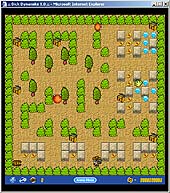
 |
 |
 |
 |
 |
 |
 |
 |
 |
 |
 |
  |
 |
||||||||||||
 |
|
|
|
 |
  DickDynamite: behind the scenes DickDynamite: behind the scenes[ June 21, 2003 ] by Marco Lapi, a.k.a Lapo This article is an overview on the features and the techniques employed in the making of "Dick Dynamite". Lapo also discusses the difficulties and the limits found working with Flash MX. Some of the complex topics touched in this article will be investigated in future articles. |
||||||||||||||||||||||||||
(continues from page 2) SERVER SIDE INTEGRATION & MODULARITY Server side integration is a very important aspect of web-based games: different informations about the game status need to be exchanged between the client and the server to make games richer : from basic highscores tables to more advanced features like saving custom made levels, all these operations cannot be achieved without using a bit of server side communication. In DickDynamite we implemented a lot of client-server interaction to manage the user maps, the LevelEditor and the Arena.
Pic 3: a custom map generated That's all for now, this was just a tour in the features that we implemented in DickDynamite and that we would like to share, so stay tuned for next articles to come. |
||||||||||||||||||||||||||




|
||||||||||||||||||||||||||
|

